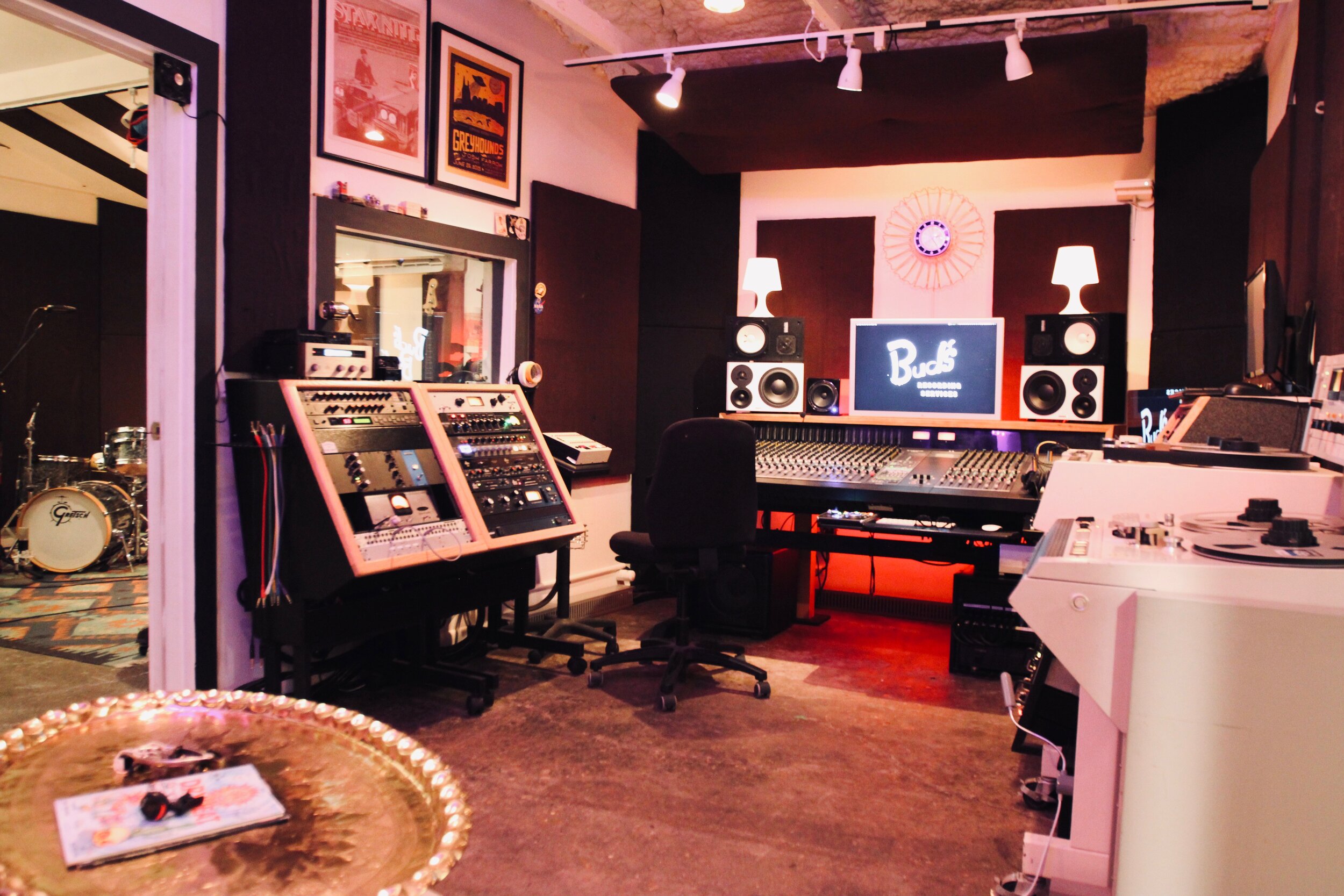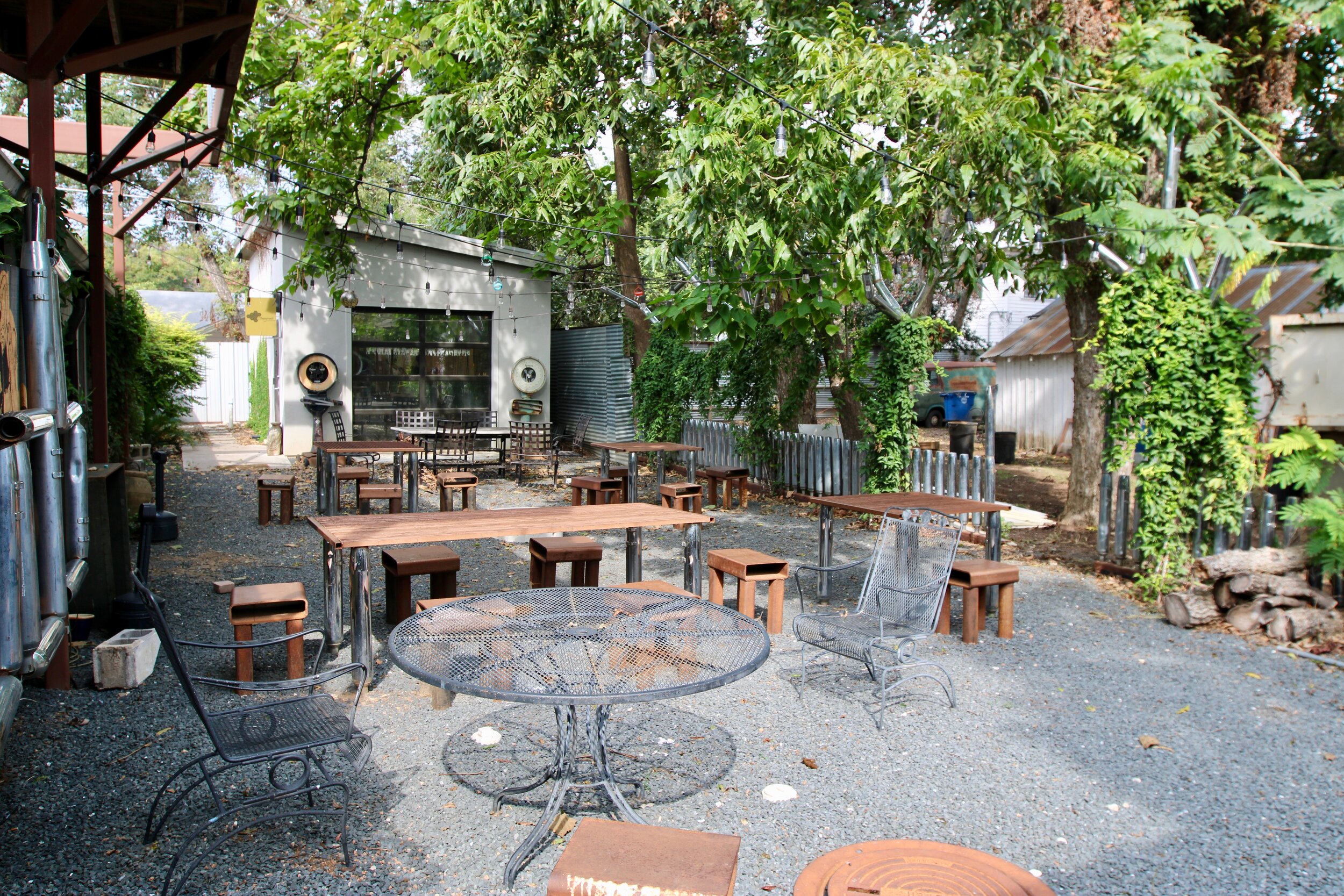Gear list
Console:
Otari Status 18R with 30 inline mono channels and 2 stereo. All analog with full snapshot recall of all parameters as well as Eagle Automation of faders and switches. VCA dynamics package on channels 1-24
Recorders/DAWs/converters:
Otari MX-70 1” 16 track
Otari MTR-10 1/4” 2 track
Cransong HEDD 192 AD/DA (2 channels AD/DA)
Motu 16A + 24Ao (16 channels of AD, 40 channels of DA with ESS Sabre 32 converter chips, clocked by HEDD 192)
Logic Pro X
Pro Tools 10-11
Steinberg Wavelab 10
Marantz PMD 501 Professional cassette recorder
Vestax MR-44 4-track cassette recorder
Monitoring:
Dynaudio LYD 48 3 way monitors with sub
Presonus Sceptre 6 Coaxial monitors
Mono Behringer Behritone speaker
Audient NERO monitor controller with 2 channels D/A
Sonarworks Sound ID Reference room correction software
Furman 6 channel Headphone system with 6 mix boxes
Preamps:
2x RCA BA-31c germanium preamps
2x Telefunken 672
1x Seventh Circle Audio N72 (Neve 1072 clone)
1x Seventh Circle Audio A12 (API 512)
1x Seventh Circle Audio T15
API 3124mb+ (4 preamps plus summing)
Pentron Tube preamp (modified 50’s tape channel)
FiveFish Audio VT-73 hybrid tube preamp
30x Otari Status 18R preamps
EQ:
2x Urei 535 with upgraded faders
SSL Ultraviolet stereo EQ
2x Kush Electr aransient EQ
32x Otari Status 18R channel EQ
Dynamics:
Stam Audio SA-4000 mkII SSL style stereo bus compressor with accurate DBX 202c VCA recreations
API 2500+ Stereo Bus Compressor
2x Kush Audio Tweezer
Grove Hill Audio Liverpool vari-mu tube compressor
Lindell 17-XS FET compressor
Klark Teknik KT-2A optical compressor
Klark Teknik 76-KT FET compressor
2x DBX 163
DBX 163x modded by Revive Audio
DBX 166 (4 channels)
DBX 263x de-esser
24x Otari Status 18R VCA compressor/gate chennel dynamics, with ability to save and recall
Microphones:
Custom made large diaphragm condenser with 47 style capsule
Custom made large diaphragm condenser with C12 style capsule
Sennheiser MD-421 U-5
Shure SM7B
EV RE-320
2x Lewitt LCT 040 pencil condensors
Lewitt LCT 240
Unidyne III 545
3x Shure SM57
Shure SM-58
2x EV 635a
Golden Age R1 Ribbon
Various character dynamic mics, ribbons, etc
Instruments/Amps:
Well maintained and great sounding 120+ year old upright piano
Hammond M3 organ
Yamaha drum kit (Early 80’s)
Gretsch Catalina 3 piece kit
Guitars by Gibson, Fender, PRS, Silvertone, etc
Fender Champ 2 (Rivera era)
Fender Vibrolux (1960s)
Fender Pro Reverb (1960’s)
Various semi-pro and toy vintage Casio and Yamaha keyboards
Various percussion
Effects:
Vesta Kaza RV-3 dual channel spring reverb
Furman RV-1 mono spring reverb
Vesta Fire DIG 411B digital delay
Eventide H3000se Ultra-Harmonizor
Yamaha SPX-90
DIYRE Colour Palette with Toneloc, Telephone, and Colourupter cards
Tel Ray oil can delay
Fender tape delay
Marantz 221 tape delay
Behringer V-Verb 2496 digital reverb
Various pedals
Plugins by UA, Soundtoys, Izotope, Valhalla, etc
DISCOGRAPHY
PROCESS
As technology has allowed recording to be more accessible to more people, some of the terms and processes that were once part of a standard language between artists, engineers, and producers, have been lost or confused by many who have never worked in a traditional studio. Although the affordability is an overall a positive effect, the confusion surrounding terms and processes can lead to unnecessary inefficiencies and frustration. For this reason, I have written this basic guide to serve as a reference.
-Sam
TRACKING
Tracking refers to the process of recording. It can be multiple elements (like a live band) recorded simultaneously, or done one element at a time with overdubs. Usually this is done as multitrack recording, as in separate elements (kick drum, snare drum, bass guitar, synth, etc) are recorded onto separate discrete tracks that can be individually processed and blended with each other. The end result of a tracking session, whether on tape or digital, is called multitracks. There could be only 2, or there could be hundreds of tracks. Bud’s offers 1'“ 16 track tape, or 1000 track count digital recording. It is also common to record to tape and then transfer to digital for additional overdubs. At the end of a tracking session, most artists like to get a rough mix of the song. This mix is more or less how the mix has sounded during tracking, and is purely used to reference what was done, and plan for what (if anything) needs to be done to the song in the following stages.
EDITING, PRE MIXING
Sometimes a song is not quite ready for mixing after tracking. Choosing which vocal or instrument takes, fixing rhythmic or pitch issues, and sometimes even full song edits like removing a verse need to be done. It can be seen as getting the song ready for mixing. This stage is not always necessary (or is wrapped into mixing), and depends on the material and the workflow of the tracking session. If the track is going to be mixed by somebody else, it may be prepared as consolidated wavs. In a nutshell, this means it can be further worked on in any DAW (digital audio workstation, such as Pro Tools)
MIXING
Mixing is the process of creating a balance mix of all the separate elements, applying equalization (EQ), effects and compression (dynamics), and creating a mono, stereo, or surround mix of the song. Before the advent of the DAW, mixing was done on an analog mixing console from the multitrack tape, to a 1 track (mono) or 2 track (stereo) tape. All EQ, dynamics, and effects were done using console based and outboard analog components. DAWs offer this process to be done inside the computer. Bud’s offers both DAW (in the box) mixing, or traditional analog mixing. Although opinions vary on this topic, the benefits of each method could be summed up as follows: DAW mixing allows for absolute recall of a mix if changes are desired. Analog mixing is usually done for the desired sonic impact imparted by the analog gear as well as the “hands on-eyes closed” approach. Although recall of an analogue mix is possible, it requires diligent note taking of the settings on the gear to produce an accurate recall. The two are also not mutually exclusive, and many mixers use the DAW as well as the tradition console approach concurrently. High end analog consoles starting in the 1980’s would often have total recall of all parameters, as well as fader and switch automation, which makes recalling an analog mix much less labor intensive than it used to be.
STEMS
Stems usually refers to sub-mixes of the multitracks. The sub-mix would usually be "like" elements, such as 6 individual drum tracks being sub mixed down to a stereo file, with all the associated processing to make them sound more or less complete. Or it could be all guitar tracks mixed to single stereo file. The purpose of stems is to provide some remix-ability in the future without having to pull up the original multitrack mix. The original multitrack mix may be impossible to recreate, whether due to changing digital technology, or an analog mix that can’t be recreated due to lack of recall notes, or the particular gear used not being available. They can also be used for creating instrumentals if they weren’t done in the mix stage, or if a movie or commercial wants only parts of the song, or if a remix artist is given permission to create a derivative work. When all the sub-mixes are summed together, that is the original mix. This is done at the end of the mix stage, and is not required, but is becoming more common.
MASTERING
Mastering is one of the least understood stages of music production. This may be due to the fact that tracking and mixing are where the broad strokes are done, where a song is born and realized. If a song were a painting, mastering would be more akin to the framing and lighting — how best to present the artwork, as a standalone piece, and/or part of a greater work.
Most of what happens in mastering is the following: critical listening, choosing the exact start and stop times of the song, equalization (for the betterment of the song and or to match an album/collection), loudness through compression and limiting, track sequencing for albums, CD authoring, and sonic texture. Sonic texture can be described as adding a little thickening or seasoning to the track, often with subtle harmonic distortion from tape or other analog gear. In a nutshell, make it sound better and louder.
LOUDNESS
Making music louder is a delicate process. A dynamic raw mix is going to sound very quiet next to a mastered pop release. In order to make the mix louder, the peaks need to be leveled off and the whole level brought up. This inherently changes the sound of the music. Genres like jazz and classical that value the pure sound of the instruments as they are heard by the human ear often employ little to no compression. Read up on the “Loudness Wars” to learn more. We have no problem making your music dynamic or slammed and loud…it’s about what you want.
FORMATS
There are generally three formats most people need their records to be released on currently: digital for streaming and downloading, CD, and vinyl. In recent years, the CD master has served as the digital streaming master as well (sometimes even the vinyl master). However, some efforts are being made to create special masters for online streaming/downloads. Mastered for iTunes is one of these, which employs uploading a 24 bit file. Still, there is no standard, and most independent artists and labels can only upload 16 bit wav files. This means the CD master is still fairly common as the digital upload as well. Vinyl however has very specific needs and limitations. If you plan to release your record on vinyl, a separate master must be created, and we must know what pressing plant it is going to press it.
WHAT DO YOU END UP WITH?
For a record or EP, we provide you with something called a DDP image. This is a digital folder that can actually be sent to a CD manufacturer for the replication process. We also send a custom player that you can install on both Mac and PC that allows you to open the DDP image and play the album exactly as it will play on CD or a streaming service. This allows you to check the track sequencing and spacing, without having to put them in iTunes or the like. You can also export individual wav files out of the program for digital upload, and burn CDs.
For vinyl masters, you will receive 2 files: side A and side B, which will be high resolution 24 bit files. We can also master your vinyl sides to 1/4” tape.
INSTRUMENTALS
For songs with vocals, It is recommended that you print instrumental mixes and send them to be mastered at the same time. If somebody wants to license your song, they are going to want the instrumental mix. We can process it through the same chain as the vocal version.






















